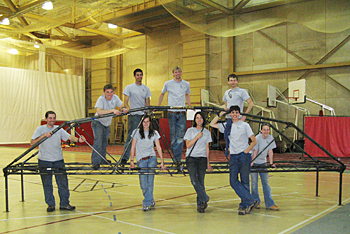
Sponsored by the American Society of Civil Engineers (ASCE) and the American Institute of Steel Construction (AISC), the SSBC requires teams of students to design and fabricate a 21-foot-long steel bridge capable of supporting 2,500 pounds of loading.
Nick Ward, a senior civil engineering major and president of the UD student chapter of ASCE, said the team plans to use feedback from the regional competition to make the bridge even better before the trip to Florida. “We need to change a couple of members to make the bridge lighter,” he said, “and we have to keep practicing to get our construction time down.”
While the UD team has qualified for nationals for the past several years and has won several first-place awards in specific competition categories, the 2008 event marked the first time Delaware finished at the top overall.
“The tremendous success of this year's team is largely due to great leadership from the team captains,” said Jennifer McConnell, an assistant professor of civil and environmental engineering who serves as ASCE student chapter adviser and as adviser to the steel bridge team. “The project also benefited from having a large number of seniors involved and a great group of dedicated underclassmen.”
The steel bridge activities are intended to supplement classroom education by providing participants with practical experience in structural design, fabrication processes, construction planning, organization and teamwork. Criteria for excellence are represented by six award categories: display, construction speed, lightness, stiffness, construction economy and structural efficiency.
Junior Tom Miner, one of two co-captains on the team, said he appreciates the value of the steel bridge experience. “We learn the theory in class,” he said, “but this competition has helped me understand how things really work.”
As project leader, Ward acknowledges the contributions made by all of the members of the team. “We had a lot of freshmen come out to help, which is great as a foundation for future years,” he said. “But it's also important to have as many juniors and seniors as possible because they've completed the coursework needed to have a better understanding of the engineering involved.”
“The entire team put a tremendous amount of time into the bridge, and it paid off,” said Tripp Shenton, interim chairperson of the Department of Civil and Environmental Engineering (CEE). “They had stiff competition from a number of good schools in the region.” Other participating teams included Drexel, Penn State, Lehigh, Lafayette, Swarthmore College, the University of Pittsburgh-Johnstown, Villanova and Widener.
The UD team had strong support from several faculty and staff members, including not only McConnell, but also Shenton; Michael Chajes, professor of civil engineering and interim dean of the College of Engineering; Danny Richardson, lab coordinator in CEE; and Steve Beard, master machinist in the Department of Mechanical Engineering. Civil engineering graduate student Dan Kucz also provided design support for the project.
“Dan was great,” Ward said, “because he asked questions instead of just giving us answers. He encouraged us to make choices that were best for the long term rather than to just adopt the solution that was easiest at the moment.”
The Student Steel Bridge Competition is aimed at increasing students' awareness of real-world issues such as spatial constraints, material properties, strength, serviceability, fabrication and erection processes, safety, aesthetics and cost. The competition also fosters teamwork and provides project management experience. The rules are changed every year to improve the competition and assure that competitors design and build new bridges.
Article by Diane S. Kukich

